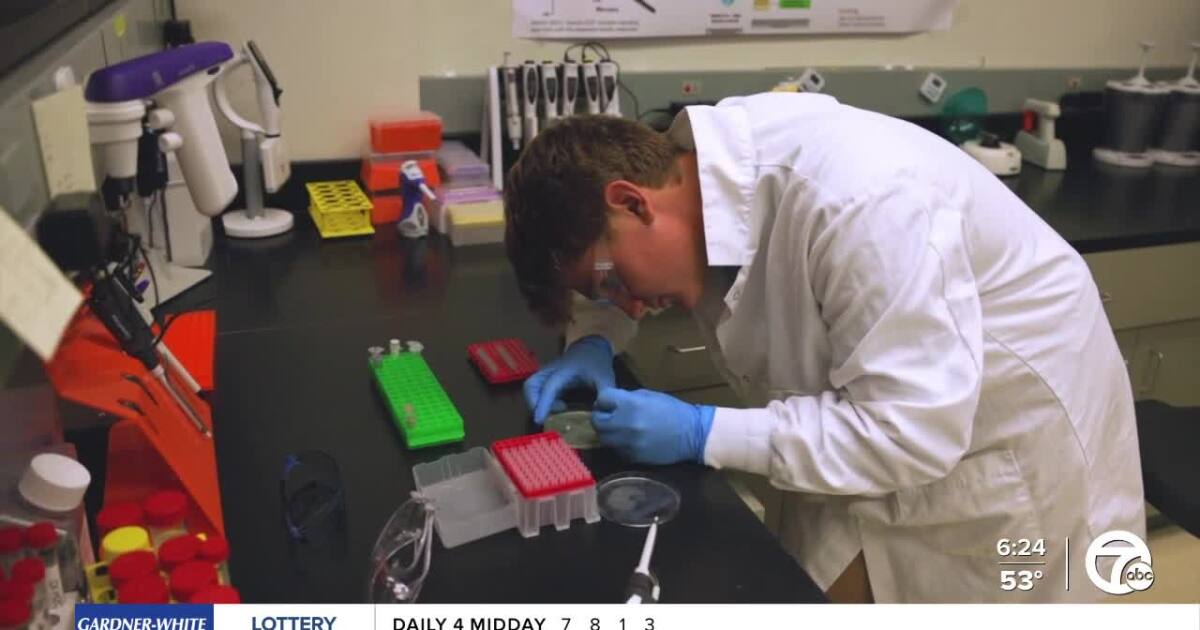Science
Central Michigan University Student Innovates Protein for Diabetes Management

A student at Central Michigan University is making strides in diabetes management with the development of a novel protein that may transform how individuals monitor their blood sugar levels. Brevin St. Onge, a neuroscience student from Mt. Pleasant, has dedicated over a year to creating a prototype protein designed to detect elevated glucose levels in the bloodstream. This innovative protein aids cells in utilizing blood sugar without relying on insulin, which could significantly impact diabetes care.
The protein functions by binding to glucose molecules when present, mimicking the natural processes typically activated by insulin. Notably, it emits light in response to glucose, with the intensity of the light correlating to the glucose concentration. This feature acts as a real-time monitoring system, offering a potential breakthrough for patients seeking less invasive methods to manage their condition.
St. Onge envisions this technology as a way to empower diabetes patients, stating, “The goal is to provide a less invasive way to track and manage their condition.” He highlights the importance of effective blood sugar management, particularly in preventing long-term complications like dementia and Alzheimer’s disease. He passionately remarked, “What difference will this make for people who suffer from diabetes or insulin resistance? Well, it will be astronomical to be completely honest with you.”
In addition to the immediate implications for diabetes management, St. Onge’s research has garnered significant attention. His work has contributed to Central Michigan University securing a $75,000 grant aimed at furthering this important research. The funding will support the continuation of the project as another student steps in to collaborate with Dr. Eric Peterson, ensuring that the momentum of this innovative work carries on.
As St. Onge prepares to apply to medical school, he remains committed to advancing diabetes research. His contributions not only highlight the potential for scientific innovation but also reflect a determination to improve the lives of those affected by diabetes. Through this groundbreaking work, he aspires to create a tangible impact, ultimately reducing the risks associated with poorly controlled blood sugar levels.
-

 Lifestyle3 months ago
Lifestyle3 months agoLibraries Challenge Rising E-Book Costs Amid Growing Demand
-

 Sports3 months ago
Sports3 months agoTyreek Hill Responds to Tua Tagovailoa’s Comments on Team Dynamics
-

 Sports3 months ago
Sports3 months agoLiverpool Secures Agreement to Sign Young Striker Will Wright
-

 Lifestyle3 months ago
Lifestyle3 months agoSave Your Split Tomatoes: Expert Tips for Gardeners
-

 Lifestyle3 months ago
Lifestyle3 months agoPrincess Beatrice’s Daughter Athena Joins Siblings at London Parade
-

 World3 months ago
World3 months agoWinter Storms Lash New South Wales with Snow, Flood Risks
-

 Science3 months ago
Science3 months agoTrump Administration Moves to Repeal Key Climate Regulation
-

 Science2 months ago
Science2 months agoSan Francisco Hosts Unique Contest to Identify “Performative Males”
-

 Business3 months ago
Business3 months agoSoFi Technologies Shares Slip 2% Following Insider Stock Sale
-

 Science3 months ago
Science3 months agoNew Tool Reveals Link Between Horse Coat Condition and Parasites
-

 Sports3 months ago
Sports3 months agoElon Musk Sculpture Travels From Utah to Yosemite National Park
-

 Science4 months ago
Science4 months agoNew Study Confirms Humans Transported Stonehenge Bluestones









